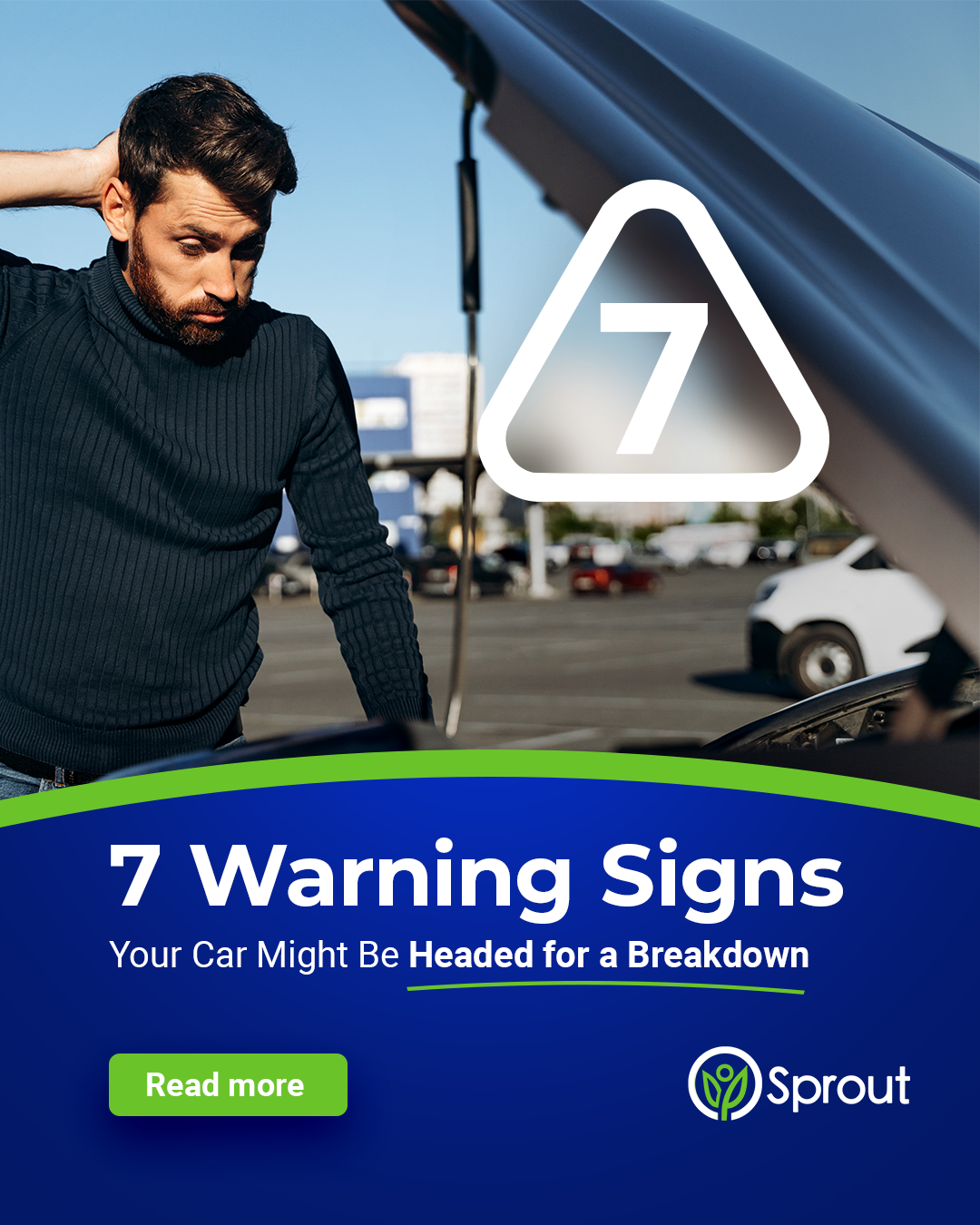You’re halfway to your weekend getaway, iced coffee in the cupholder, a playlist worthy of your favorite DJ, and then the car shudders at a stoplight.
Just once.
Then again.
Then… nothing.
Dead on the side of the road with no cell signal and a long wait ahead.
Your worst fear?
Perhaps not literally, but many drivers have faced some version of this.
The worst part? In many cases, there were warning signs. They just didn’t seem serious enough to act on.
That’s why we made this helpful guide: to help you recognize the real red flags before they lead to a full-blown breakdown. And more importantly, to show you how to prepare in case the worst does happen.
Here are seven ways your car warns you that something is wrong.
1. Dashboard Lights That Don’t Go Away
You get in, buckle up, start the car, and a warning light you’ve never seen before flashes.
Maybe it’s the check engine light, the battery indicator, or the temperature gauge (the symbols can sometimes be cryptic, so when in doubt, check your owner’s manual, usually online since many newer vehicles don’t come with an old-school hardcopy anymore).
You tell yourself, “Huh. It’s probably nothing,” and head off to work like normal.
Here’s the truth: everything is not normal. Dashboard lights are your car’s first cry for help. Some are more urgent than others, but ignoring them could turn a $100 repair into a $1,500 one fast.
According to CarMD’s 2024 Vehicle Health Index, check engine light issues alone account for nearly 70% of diagnostic trouble codes, and the top culprits include ignition coils, catalytic converters, and oxygen sensors, all of which can snowball into major repairs if left unchecked.
Red lights = immediate attention. Yellow lights = investigate ASAP.
Don’t ignore:
- Flashing check engine light (could signal misfire damage)
- Overheating indicators
- Brake warning lights
EV/Hybrid drivers: Newer dashboards show errors like battery cooling faults or high voltage system warnings, which should never be ignored.
2. Strange Noises That You Didn’t Hear Yesterday
Cars aren’t supposed to hiss, grind, clunk, or squeal. If they do, something’s wrong.
It may not break down today, but time in the repair shop is probably not far off.
Listen for some of these warning signs:
- Squealing when applying the brakes = worn brake pads or warped rotors
- Grinding when shifting = a transmission or clutch issue
- Knocking or ticking from the engine = potential oil or valve problem
- Whining under the hood = possible serpentine belt or alternator issue
Pro tip: Pay attention to when the sound occurs and what it sounds like. Acceleration? Braking? Turning? Squeal? Knock? Hiss?
These are all clues your mechanic can use to diagnose and fix the problem quickly.
3. Smells That Make You Go, “What Is That?”
Trust your nose. You know what your car normally smells like. Unusual smells are often the first sign of trouble, especially with electrical systems, leaks, or overheating.
Never ignore something out of the ordinary, like:
- Sweet, syrupy odor = a coolant leak
- Burning rubber = slipping belts or overheated components
- Rotten eggs = catalytic converter or fuel system problem
- Hot plastic = electrical short or wiring issue
If something smells off, trust your instincts. Especially in hybrids and EVs, battery overheating can emit a distinct chemical smell, which poses a serious fire risk if not addressed immediately.
4. Trouble Starting or Power Loss on the Road
A car that struggles to start or suddenly loses power while driving is waving a big red flag. This warning sign may indicate one of several potential causes, so don’t delay taking it to your trusted mechanic as soon as you can.
It could be the battery, the fuel pump, or deeper electrical or engine issues.
Warning signs:
- Sluggish crank when turning the key or pushing the start button
- Engine stalling or “sputtering” under acceleration
- Sudden drop in power, even with the pedal pressed
EV/Hybrid tip: EVs may show range inconsistencies, system warnings, or reduced power mode, all of which are indicators of trouble within the battery or drive unit.
5. Leaks, Drips & Puddles
If your driveway or garage looks like an abstract painting of fluids, don’t ignore it.
Your car should not be leaking, and every fluid drip is a warning.
What the colors mean:
- Bright green or orange = coolant
- Reddish fluid = transmission
- Clear, oily fluid = brake or power steering
- Black or brown = engine oil
What should you do immediately?
Place cardboard under your car overnight. If the spot reappears in the morning, indicating an active leak, call your mechanic before you call the tow truck.
6. Overheating, Especially in Hot Climates
Your engine is going to run hot, but it’s not supposed to overheat. If the temperature gauge spikes or steam starts rising from the hood, pull over immediately, turn off the engine, and call for help.
Causes of overheating can include:
- Broken radiator fan
- Coolant leaks or blockages
- Failed water pump
- Battery thermal system malfunction (in EVs)
According to AAA’s 2025 maintenance report, cooling system failures are among the top five causes of roadside breakdowns in the U.S.
Pro tip: Keep coolant levels topped off and inspect your radiator and hoses seasonally, especially before summer road trips.
7. Electrical Gremlins That Come and Go
One flickering light? Maybe. But if your headlights dim, the radio resets, or your power windows act up, your electrical system may be crying for help.
These could signal:
- Weak battery or failing alternator
- Poor connections or corrosion
- DC-DC converter issues in EVs
Here’s an interesting fact: Many drivers report electrical issues as the first symptom of battery failure, both in gas cars and electric models. Don’t wait for a total shutdown before you investigate.
So, What Should You Do? 3 Things
First: Don’t panic.
These warning signs don’t mean you’re doomed. They mean your car is trying to help you prevent something worse from happening.
Second: Don’t delay getting the problem looked at. Addressing a small problem today can save you thousands tomorrow.
Third: Have a plan for when things go sideways anyway. Because sometimes, even the most diligent drivers end up stuck.
The Smartest Backup Plan: Mechanical Breakdown Coverage
Just like you wouldn’t go without health insurance, you shouldn’t go without a plan for your car. Because when breakdowns happen (and they will), coverage can mean the difference between a smooth fix and a serious financial headache.
That’s where Sprout Assure comes in.
With our Auto Club Membership, you’ll get:
- Comprehensive Mechanical Breakdown Coverage
- Access to any licensed mechanic or repair shop (no networks or hoops)
- Plans with $0 or low deductible
- 24/7 roadside assistance
- $150/year towing reimbursement
- $100/year towards oil changes
- Easy enrollment and no-hassle claims
It’s the smart, affordable way to protect yourself before the tow truck shows up.
Explore coverage options and join today.
Remember the scenario at the top? You, the open road, iced coffee, and then… silence.
That version of the story didn’t have to end in a breakdown.
With the right awareness and the right coverage, you can catch the warning signs early, fix issues affordably, and hit the road with confidence.
Because when your car gives you clues, the smartest thing you can do is listen.


